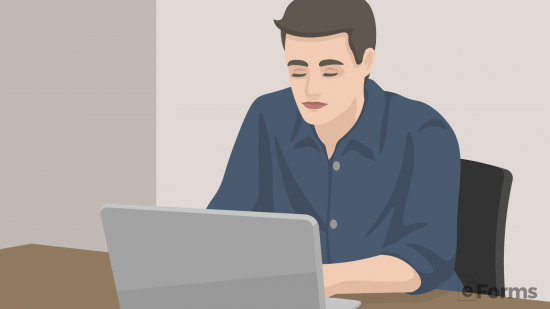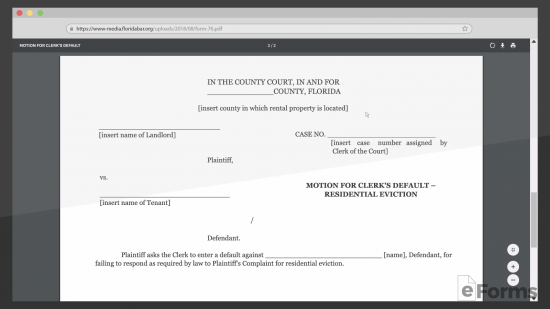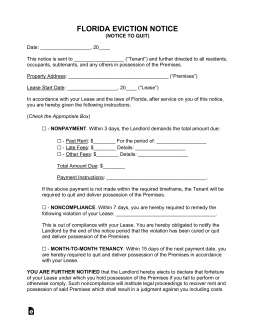Updated February 19, 2024
A Florida eviction notice is a memo given by a landlord to a tenant for a violation of their lease contract. The notice must be delivered directly to the tenant or posted on the property (on the door). It must include the details of the violation and the time period the tenant has to fix the issue. If the tenant does not adhere to the notice to quit, the landlord may seek eviction proceedings.
By Type (3)
 3-Day Notice to Quit (Non-Payment of Rent)– This form of notice is used when a tenant has failed to pay rent when it is due under the terms of the lease. The landlord may send this notice and the tenant has three days to respond by either paying the rent or moving out of the premises. 3-Day Notice to Quit (Non-Payment of Rent)– This form of notice is used when a tenant has failed to pay rent when it is due under the terms of the lease. The landlord may send this notice and the tenant has three days to respond by either paying the rent or moving out of the premises.
Download: PDF |
 7-Day Notice to Quit (Non-Compliance) – This form of notice is used when a tenant has failed to abide by other aspects of the lease other than non-payment of rent. The landlord may deliver this form requesting that the tenant correct the problem or vacate within seven days. 7-Day Notice to Quit (Non-Compliance) – This form of notice is used when a tenant has failed to abide by other aspects of the lease other than non-payment of rent. The landlord may deliver this form requesting that the tenant correct the problem or vacate within seven days.
Download: PDF, MS Word, OpenDocument |
 15-Day Notice to Quit (Month-to-Month Tenancy)– This form is used to inform a tenant that a month-to-month lease will not be renewed and that he or she is required to move out at the end of fifteen days. 15-Day Notice to Quit (Month-to-Month Tenancy)– This form is used to inform a tenant that a month-to-month lease will not be renewed and that he or she is required to move out at the end of fifteen days.
Download: PDF, MS Word, OpenDocument |
Table of Contents |
Court Forms
Complaint for Eviction and Damages – This complaint is filed when the plaintiff is seeking eviction as well as unpaid rent and other money owed.
Complaint for Eviction re-Breach – The plaintiff will use this document if the defendant has breached the lease agreement in a manner other than non-payment of rent.
Complaint for Eviction – The plaintiff will use this document should they seek to evict for the non-payment of rent but they are not seeking damages.
Summons for Damages Complaint – This will be delivered to the tenant to notify them that there is a court case against them and that the landlord is officially seeking damages.
Summons for Eviction-Only Complaint – This summons will notify the tenant that there are no damages being sought by the landlord but that they are suing for eviction.
Tenant’s Written Response – The tenant will have five days to respond to the claims for an eviction and 20 days should the landlord seek damages.
Motion for Clerk’s Default – Eviction only – This document is filed along with a Non-Military Affidavit should the tenant fail to respond within the five-day window. It requests a default from the court clerk in favor of the landlord due to the tenant’s failure to respond.
Motion for Default Final Judgment – Eviction Only – This document is to request a final judgment in favor of the landlord from the judge handling the case. It can be filed after the above Motion for Clerk’s Default.
Motion for Clerk’s Default with Damages – This document is filed with the Non-Military Affidavit to request a default judgment against the tenant from the court clerk for eviction plus damages.
Motion for Default Final Judgment with Damages – This motion is filed following the Motion for Clerk’s Default should the defendant fail to file a response. It requests that the judge handling the case award a default judgment in favor of the plaintiff.
Non-Military Affidavit. – Indicates that the defendant is not in the military. Filed in conjunction with the Motion for Default Judgment forms.
Final Judgment – Eviction – Completed by the judge should the landlord win the case. It is legal proof that the defendant must leave the premises of the property and that possession be returned to the plaintiff.
Final Judgment – Damages – Completed if the judgment is in favor of the landlord. This indicates that the tenant must leave the property and pay the damages owed.
Writ of Possession – A Writ of Possession, once approved by the clerk of court and delivered to the Sheriff, is used to notify the tenant that they have 24 hours to vacate or they will be forcibly removed.
How to Evict a Tenant (4 steps)
- Send Eviction Notice
- File Complaint and Summons
- Set Court Date or File Motion
- Receive Court Judgment
1. Send Eviction Notice

Before any court proceedings for eviction can proceed, a landlord must provide the tenant with written notice. In case of a breach for nonpayment of rent, the landlord may use the 3-Day Notice to Quit (Non-Payment of Rent). If the breach is due to other violations, the landlord may use the 7-Day Notice to Quit (Non-Compliance). If the landlord is seeking to terminate a lease, the landlord should use this 15-Day Notice to Quit (Month to Month).
2. File Complaint and Summons

If the tenant fails to respond to the written notice in the time period allowed, the landlord may begin eviction proceedings by filing a complaint and summons with the County Court where the property is located. There are three different complaints depending on the situation.
Complaints
- Complaint for Eviction and Damages – This complaint is used when the landlord seeks to obtain damages, such as back rent, cleaning costs, repair costs, etc. in addition to having the tenant evicted.
- Complaint for Eviction re-Breach – This complaint is for use when the landlord is just seeking to evict for a breach other than nonpayment of rent, and not seeking damages.
- Complaint for Eviction – The landlord may use this form when seeking to have a tenant evicted for non-payment of rent, but not seeking damages.
The landlord will also have to file a summons with the complaint, depending on which complaint is filed:
Summons
The landlord must provide four copies of the notice sent to the tenant. In addition, the landlord will have to pay a filing fee[8][9][10] of $185 (or more if damages are greater) in addition to:
- Service of Process: $40
- Summons: $10 (for each)
- Writ of Possession: $90
3. Set Court Date or File Motion

If the tenant responds, a court date will be set. If the tenant does not respond, the landlord must prepare three copies of the following documents for the court:
For an eviction only:
For eviction and damages:
First, the landlord will file the Motion for Clerk’s Default with the Clerk of Court along with a Non-Military Affidavit. Depending on the result of the Clerk Default, the landlord may file the Motion for Default Final Judgment requesting that a judgment be made in their favor due to the tardiness of the tenant’s response. Should they be requesting damages in addition to the eviction, they will need to file an Affidavit of Damages.
4. Receive Court Judgment

Should the Court rule in favor of the landlord, they will provide either a Final Judgment – Eviction, or a Final Judgment – Damages. A copy should be retrieved by the landlord. They will then be able to obtain a Writ of Possession which, once signed by the Clerk of Court and delivered to the Sheriff, gives the tenant 24 hours to exit the premises.


